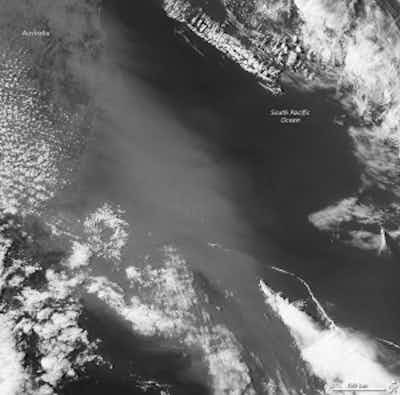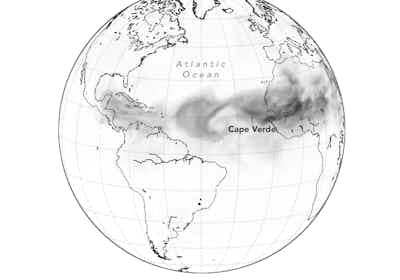Many people live in parts of the world where dust haze, dust storms and even sandstorms are a recurring feature of the environment. For many others, they are less common events, which nevertheless raise a lot of concern and attention when they do occur: for example, recent dust storms in eastern Australia, or the Dust Bowl era storms on the North American prairies.
Dust storms crossing oceans to other continents
Perhaps the most remarkable thing about dust storms is how far from the source their effects can be felt: glaciers and snow in New Zealand receive a red tinge from the Australian desert at times, and dust from the Sahara is responsible for subduing Atlantic hurricanes reaching the Caribbean and US.

The map above shows dust crossing the Atlantic on June 28, 2018, as represented by the Goddard Earth Observing System Model, Version 5 (GEOS-5). Courtesy of NASA Earth Observatory.
Although there are many regions globally where dust storms occur, the key source regions in the northern hemisphere are the Sahara and northern China, while south of the equator the Australian deserts are the main sources.
Australian dust storms spanning several states
The current Australian summer has seen record dry and heat in many parts, desiccating soils and reducing vegetation cover. Grazing and cultivation can exacerbate the loss of ground cover. The necessary ingredient then is strong wind to pick up soil particles and inject them high into the air.
A gusty dry thunderstorm might create a spectacular local dust storm, but a larger system like a strong cold front can raise dust across hundreds of kilometres, creating particle clouds easily visible from space. A large dust storm affected eastern Australia in September 2009, at one stage stretching a whopping 3450 km across.

A wall of dust stretching from northern Queensland to the southern tip of eastern Australia on the morning of September 23, 2009. Courtesy of NASA Earth Observatory.
Dust storms are capable of property damage and loss of life, transport disruption, soil degradation and health effects from exposure to high concentrations of fine particles. Adequate warning and a host of land management measures are the best protection against the worst effects of these natural hazards.
